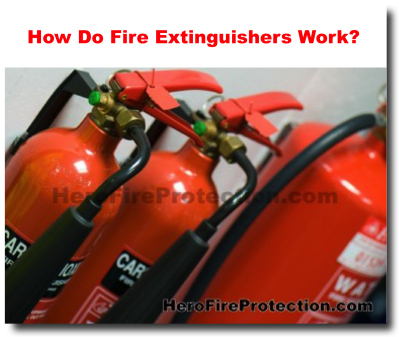How Do Fire Extinguishers Work?
- Tweet

Fire extinguishers are an essential part of any fire safety plan. Using the wrong kind of fire extinguisher can be dangerous. Here's what to know about different types of fires and the types of fire extinguishers that are recommended for home use.
There are three components to a fire: oxygen, heat, and fuel. This is commonly referred to as thefire triangle. The fuel can be any type of flammable material that, when introduced to enough heat to reach its ignition temperature, catches fire. Oxygen creates continued combustion to keep the fire going.
All three elements of the fire triangle are required to sustain a fire. A fire extinguisher works by removing at least one of these elements, putting the fire out.
Class A Fire Extinguisher – Class A fire extinguishers are used for ordinary combustibles, such as paper, wood, cloth, and some types of plastic. This is the most common type of fire and these extinguishers typically use water or certain types of dry chemicals to either absorb heat or coat the fire.
Class B Fire Extinguisher – Class B fires involve flammable liquids like oil, alcohol, or gasoline and might occur anywhere flammable liquids or gases are used or kept. Class B fire extinguishers work by cutting off a fire's oxygen supply, using foam, powder, or carbon dioxide. A water extinguisher should not be used on a Class B fire as the stream of water might spread the flaming material rather than extinguish it.
Class C Fire Extinguisher – Class C (or Class E in Australia), fires involve electrical equipment. Class C fire extinguishers are effective against electrical fires from live wires, panels, and circuit breakers. The extinguisher works by releasing materials that stop the conduction of electricity like carbon dioxide or dry powder. Do not try to put out Class C fires with a water or foam extinguisher since these can conduct electricity and can make the situation worse.
Class D Fire Extinguisher – Class D fire extinguishers are used on combustible metals using dry powder. Class D fires are uncommon but occurs when a metal ignites such as magnesium, sodium, aluminum, and titanium. It takes high levels of heat to ignite most metals, which makes Class D fires rare outside of laboratories and industrial settings.
Class K Fire Extinguisher - Commonly used in restaurant kitchens, class K fire extinguishers can effectively put out fires caused by cooking fats, greases, and oils. Class K (or Class F in the UK) fires involves cooking oils such as vegetable oil or animal fats. Although they are sometimes combined with Class B fires, these fires involving cooking oils to be in their own category because of their high flash point.
If you are not confident in using a fire extinguisher, err on the safe side and immediately evacuate after yelling to alert anyone nearby.
If you would like to have your home evaluated for fire safety, let Hero Fire Protection help! We are a full-service fire protection company in Hawaii dedicated in educating families about the devastating effects of home fires and other home safety issues. Contact us today to get a FREE fire safety assessment and receive a FREE emergency kit.
ref no:33918
Please send questions about this website to webmaster
Copyright© 2019 - 2023 HeroFireProtection.com. All rights reserved.
Terms of Use / Legal Disclaimer / Privacy Statement
Site Designed and Managed by MacBusiness Consulting
Terms of Use / Legal Disclaimer / Privacy Statement
Site Designed and Managed by MacBusiness Consulting
